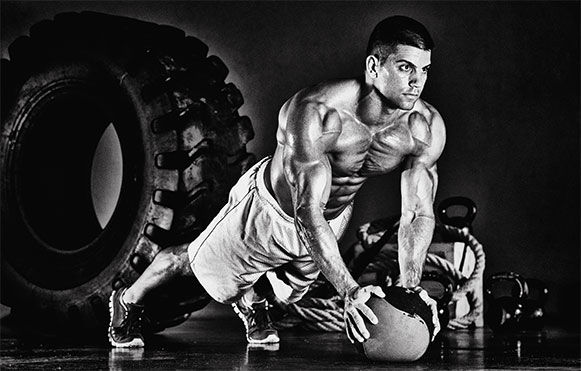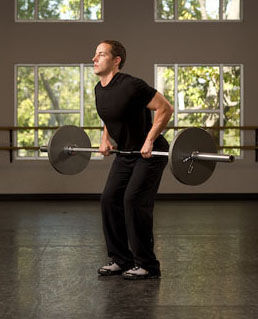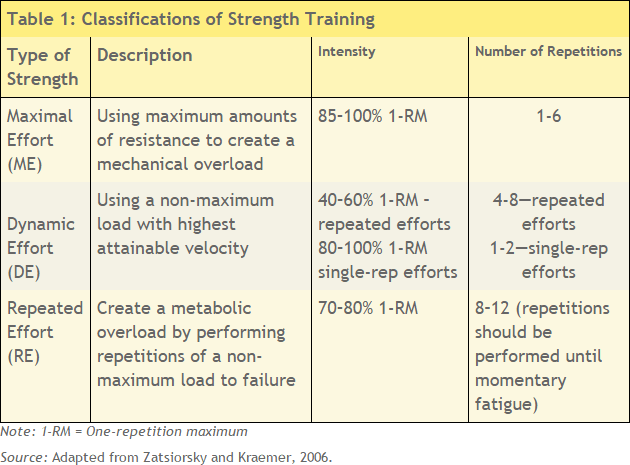
Resistance training is the process of exercising with external resistance for the purpose enhancing the functional performance of muscle, improving physical appearance or a combination of the two, and is a primary reason why many individuals start a workout program. Resistance training can both improve strength and increase muscle size simultaneously; however, there is a distinct difference between training for maximum force output (strength) and muscle growth. Resistance training alone does not induce muscle growth; the training load has to cause fatigue to stimulate the physiological mechanisms responsible for increasing muscle mass. The overload principle of exercise program design dictates that to stimulate physiological changes such as muscle growth, it is necessary to apply a physical stimulus at an intensity greater than the body is accustomed to receiving. Muscle growth from resistance training occurs by either increasing muscle fiber thickness or the volume of fluid in the sarcoplasm of muscle cells.
Understanding how the muscular system adapts to the imposed demands of resistance training can help you determine the best way to train your clients for maximal muscle growth. Existing research offers guidance as to how the body may respond to a stimulus, but each individual will experience a slightly difference physiological outcome to the imposed demands of resistance-training exercise. The ability to add mass and increase the level of lean muscle is based on a number of different variables including gender, age, resistance-training experience, genetics, sleep, nutrition and hydration. Other emotional and physical stressors, each of which applies a stress that can change how an individual’s physiological systems adapt to resistance training, also influence one’s ability to add mass. For example, too much stress at work or a lack of sleep may significantly reduce the ability to grow muscle. Knowing how to apply this science, however, can greatly influence your ability to help your clients maximize their results.
Mechanical and Metabolic Stress
It is well known that physical adaptations to exercise, including muscle growth, depend on the application of the acute variables of program design. There is absolutely no question that resistance training leads to muscle growth; however, the science is undecided on exactly what causes muscle growth. Resistance training causes two specific types of stress—metabolic and mechanical—and both types can provide the necessary stimulus for muscle growth (Bubbico and Kravitz, 2011). Brad Schoenfeld is a researcher who has performed exhaustive literature reviews on training for muscle growth. “Mechanical stress is unquestionably a primary driving stimulus in post-exercise muscle growth,” explains Shoenfeld. “There is compelling evidence that metabolic stress may also contribute to hypertrophic adaptations. A problem with the research is that mechanical and metabolic stress occur in tandem, making it difficult to tease out the effects of one from the other” (Schoenfeld, 2013).

Mechanical stress refers to the physical stresses applied to the structures of the motor neuron and its attached muscle fibers, collectively referred to as a motor unit. Resistance training causes microtrauma to muscle tissue which in turn signals the biochemical reaction to produce new satellite cells responsible for repairing the mechanical structure of the muscle tissue as well as building new muscle proteins (Schoenfeld, 2013; 2010). Additionally in his research on cellular adaptations to resistance training Spangenburg (2009) recognized that “mechanisms activated during mechanical loading of muscle signal changes that create hypertrophy.”
Metabolic stress occurs as the result of a muscle producing and consuming the energy required to fuel contractions. The moderate-intensity, high-volume training programs responsible for muscle growth use the glycolytic system of energy production. A by-product of anaerobic glycolysis is an accumulation of lactate and hydrogen ions that changes blood acidity and creates acidosis. Evidence suggests a strong relationship between blood acidosis and the elevated levels of growth hormone that support muscle protein synthesis. In their review of the research, Bubbico and Kravitz (2011) noted that, “Metabolic stress, a result of the by-products of anaerobic metabolism (i.e., hydrogen ions, lactate and inorganic phosphate), is now also believed to promote hormonal factors leading to muscle hypertrophy.”
There are two specific types of hypertrophy (the technical term for muscle growth). Myofibrillar hypertrophy refers to the increase in size or thickness of individual actin and myosin protein filaments, which can improve the force production capacity of the myofibrils. Myofibrillar hypertrophy does not lead to larger muscles; rather, it results in thicker muscle fibers capable of generating more force. Sarcoplasmic hypertrophy is an increase in the volume of the semifluid interfibrillar substance in the intercellular space that surrounds an individual muscle fiber. This fluid contains the proteins used to promote tissue repair and growth. Sarcoplasmic hypertrophy can cause the cross-sectional area of muscle fibers to increase, but most of the enhanced muscle size is due to an additional volume of the sarcoplasm and non-contractile proteins not directly involved with force production. Resistance training with heavy loads to fatigue can result in a combination of sarcoplasmic and myofibrillar hypertrophy (Schoenfeld, 2010; Baechle and Earle, 2008; Zatsiorsky and Kramer, 2006).
Designing exercise programs that build muscle mass requires knowing how to apply the stress of exercise in a way that doesn’t create negative interference with other stressors. A good personal trainer should know how to manage exercise stress in such a way to promote an optimal response from a workout program. Designing a resistance-training program with a proper application of variables—specifically the exercises, intensity, repetition ranges and rest intervals—to create both a metabolic and mechanical demand on muscle tissue can stimulate the production of hormones and promote the synthesis of contractile proteins responsible for muscle growth (Schoenfeld, 2013; Bubbico and Kravitz, 2011).
Mechanical Stimulus
Knowing how to design exercise programs to stimulate maximal muscle growth requires an understanding of muscle fiber physiology. A motor neuron receives an action signal from the central nervous system (CNS), causing the attached muscle fibers to shorten and contract. There are two basic muscle-fiber classifications: type I (slow-twitch) and type II (fast-twitch). Type I, slow-twitch muscle fibers, are also known as aerobic muscle fibers due to their ability to create energy from oxygen, allowing them to produce force over an extended period of time. The two types of type II muscle fibers discussed most frequently in exercise physiology texts are IIa and IIb. Type IIb fibers use stored adenosine triphosphate (ATP) to generate a high amount of force in a short period of time without the use of oxygen making them completely anaerobic. Type IIa fibers can take on characteristics of either type I or type IIb fibers, depending on the applied training stimulus (Baechle and Earle, 2008; Zatsiorsky and Kraemer, 2006).
The initial improvements in strength from a resistance-training program are primarily due to improved neural function as external resistance creates a stimulus that increases both the number of motor units activated and their speed of contraction. One of the long-term adaptations of muscle to resistance training is an increase in muscle fiber cross-width. As the cross-sectional area increases in size, the fibers have more surface tension and become capable of generating higher amounts of force. Muscles with a larger cross-sectional area of individual muscle fibers are capable of producing greater amounts of force. Despite a common misperception that lifting weights can lead to an immediate increase in muscle size, it can take eight weeks or longer, even in a well-designed program, for significant muscle growth to occur.
According to the all-or-none theory, a motor unit is either active or inactive; however, when it is stimulated to contract it activates all of the muscle fibers connected to it. Slow-twitch motor units have a low threshold for activation and low conduction velocities, and are best suited for long-duration activity requiring minimal force output because they attach to type I muscle fibers. Fast-twitch motor units are attached to type II muscle fibers and have a higher activation threshold, are capable of conducting signals at higher velocities and are better suited to producing force rapidly because they can produce ATP quickly without the need for oxygen. Fast-twitch muscle fibers also have a greater diameter than type I fibers and play a more significant role in hypertrophy. Recruiting and innervating type II muscle fibers requires creating enough mechanical and metabolic overload to fatigue the involved muscle by the end of the set (Zatsiorsky and Kraemer, 2006).
Metabolic Stimulus
Muscle motor units are recruited via the size principle with smaller, type I motor units recruited first before the larger type II fibers capable of generating the force necessary to move heavy loads. When type II muscle fibers are recruited, they use stored muscle glycogen to create the ATP required for contraction and this leads to an adaptation that can greatly influence muscle size. As muscle cells deplete glycogen for fuel, they will adapt by storing more glycogen during the recovery phase. One gram of glycogen will hold up to 3 grams of water when stored in muscle cells. Performing high repetitions to momentary fatigue can not only create the acidosis to stimulate growth hormone production, but can also deplete stored muscle glycogen, resulting in an increase in muscle size once it is replenished (Schoenfeld, 2013).
According to David Sandler, the Director of Science and Education for iSatori Nutrition and a former strength coach for the University of Miami, mechanical stress probably plays a greater role in inducing muscle growth. “Weight lifting creates structural damage and degrades muscle proteins. Once the damage has occurred the body will release proline-rich peptides as a signal to the endocrine system to initiate the repair process.”
Endocrine Stimulus for Hypertrophy
The endocrine system produces the hormones that control cellular function. Mechanical and metabolic stress applied to muscle fibers trigger the endocrine system to increase the production of the hormones responsible for repairing damaged muscle tissue and growing new protein cells. The hormones testosterone (T), growth hormone (GH) and insulin-like growth factor (IGF-1) are produced as a response to resistance training because they promote the protein synthesis responsible for repairing and growing new muscle (Schoenfeld, 2010; Vingren et al., 2010; Crewther et al., 2006). The rate of protein utilization and subsequent muscle growth is related to the damage of the muscle fibers involved in training. Moderate to heavy loads performed for higher repetition ranges can generate higher levels of mechanical force, which creates more damage to muscle protein and signals the production of T, GH and IGF-1 to remodel protein and build new muscle tissue (Crewther et al., 2006).
The endocrine system experiences acute and chronic adaptations to resistance training, both of which are essential for muscle growth. In the acute phase immediately post-exercise, the endocrine system will produce T, GH and IGF-1 to promote repair of the damaged tissue. The long-term endocrine system adaptation is an increase in the receptor sites and binding proteins, which allow T, GH and IGF-1 to be used effectively for tissue repair and muscle growth (Schoenfeld, 2010; Baechle and Earle, 2008; Crewther et al., 2006). Schoenfeld (2010) observed that muscle damage as a result of mechanical tension and metabolic stress from high-intensity exercise is an effective stimulus for producing the hormones responsible for cellular repair and that IGF-1 is “probably” the most important hormone for enhancing muscle growth. Whether the endocrine system is influenced more by mechanical or metabolic stress is not certain; however, research indicates that organizing the volume and intensity of a training session to feature heavier loads with shorter rest periods can lead to an increase in the production of anabolic hormones that promote muscle growth (Schoenfield, 2013; 2010; Wernbom, Augustsson and Thomee, 2007; Crewther et al., 2006).
Resistance Training for Muscle Growth

It is simply not enough to lift a weight for a high number of repetitions if it does not cause momentary muscle fatigue. The body is extremely efficient at conserving and utilizing energy, so if the same exercise is repeatedly performed with the same load then it could limit the amount of mechanical or metabolic stress placed on the muscle and minimize the training effect. To stimulate muscle growth, the variables of exercise program design must be applied in a manner that places a mechanical stress on the muscle tissue and also creates a sizable metabolic demand. Zatsiorsky and Kraemer (2006) identified three specific types of resistance training: the Maximal Effort Method, the Dynamic Effort Method and the Repeated Effort Method (Table 1).
Maximal Effort Method
The Maximal Effort (ME) Method of strength training uses heavy loads to enhance motor unit activity by innervating the higher threshold type-II motor units and their attached muscle fibers. ME training can improve both intramuscular coordination, which is the number of motor units functioning within a specific muscle, along with intermuscular coordination, which is the ability of a number of different muscles to time their firing rates to contract simultaneously. The primary stimulus of ME training is mechanical; specifically, myofibrillar hypertrophy, which can greatly increase the force output of a muscle without adding too much size. The ME method is effective for strength development, but is not the most effective approach for increasing muscle size.
The Dynamic Effort Method
The Dynamic Effort (DE) Method of strength training uses non-maximal loads moved at the highest attainable velocity to stimulate the muscle motor unit. The DE Method activates the contractile element of muscle to create an isometric contraction and place tension on the body-wide network of fascia and elastic connective tissue. When the contractile element shortens, it loads the fascia with elastic mechanical energy that, when rapidly shortened, creates an explosive action to move an external load. The DE Method is the most effective means of increasing the rate of force development and developing explosive power required for many sports or dynamic activities. However, training with the DE Method does not place a significant amount of either mechanical or metabolic stress on the contractile element of muscle, which are necessary for stimulating muscle growth.
The Repeated Effort Method
The Repeated Effort (RE) Method of strength training requires the use of a non-maximal load performed until momentary muscle failure (the inability to perform another repetition). By performing the final few repetitions per set in a fatigued state to stimulate all of the motor units, the RE Method can engage all the fibers in an involved muscle and create a significant overload. Due to high repetition ranges performed with a moderately heavy load, the RE Method stimulates hypertrophy by creating both a mechanical and a metabolic overload, and is frequently used by bodybuilders for increasing lean muscle mass. The RE Method utilizes slower motor units for the initial repetitions; as these motor units begin to fatigue, the muscle will recruit type II high-threshold motor units to sustain the necessary force production. Once the high-threshold motor units are activated, they fatigue quickly, leading to the end of the set. As anaerobic type II fibers are used, they create energy through anaerobic glycolysis, which produces metabolic waste like hydrogen ions and lactate that change blood acidity. Research suggests that acidosis—the change in blood acidity due to an accumulation of blood lactate—is associated with an increase in GH and IGF-1 to promote tissue repair during the recovery phase (Schoenfeld, 2013; 2010).
It is important to note that if the load is not sufficient or the set is not performed to failure, then it will not stimulate the type II motor units or create the requisite metabolic demand that help promote muscle growth. The RE Method provides three key advantages:
- It has a greater impact on the metabolic function of the muscle, provoking greater levels of hypertrophy.
- It involves a significant number of motor units, leading to strength gains.
- It can have a lower risk of injury when compared to the ME Method of training.

Rest and Recovery
Often the most overlooked variable of any exercise program is the post-workout recovery period. Whether it is mechanical or metabolic stress that provides the stimulus for muscle growth is not as important as allowing the time for T, GH and IGF-1 to promote muscle protein synthesis after a training session. Exercise is a physical stimulus applied to a muscle and is only part of the equation responsible for muscle growth. Adequate recovery is essential to allow the trained muscles sufficient time to replace muscle glycogen and the physiological process to repair and rebuild new tissue. The most active period of protein synthesis is the 12 to 24 hours after a hard training session. The frequency of training a muscle group is dependent upon the individual’s training goals, experience and conditioning status. Appropriate recovery for muscle growth is approximately 48 to 72 hours before exercising the same muscle group.
Inducing metabolic and mechanical stress in the gym will only go so far in promoting muscle growth. T and GH are produced during the REM cycles of sleep, meaning that a full night’s rest is critical for promoting muscle growth after strength training. Insufficient rest and recovery does not allow for optimal muscle protein synthesis and could lead to an accumulation of energy producing hormones like epinephrine and cortisol, which can reduce the ability to generate new muscle tissue. Loss of sleep, loss of appetite, lingering illness and cessation of gains from exercise are all symptoms of overtraining, which can significantly affect an individual’s ability to achieve his or her fitness goals (Beachle and Earle, 2008). “Under recovered” is another way to think of overtraining. “Promoting muscle growth requires periods of off-loading (active rest) to allow for a complete recovery,” says Schoenfeld (2013). When working with clients to promote muscle growth, encourage them to allow proper time for sleep to ensure optimal results.
Developing a Workout Program for Muscle Growth
The standard protocol for hypertrophy training requires performing eight to 12 repetitions with enough intensity to induce momentary fatigue by the last repetition. Short- to moderate-duration rest intervals of 30 to 120 seconds help create a sizable metabolic demand. Completing three to four sets per exercise ensures an effective mechanical stress on the involved tissues. The tempo of movement should be relatively short during the concentric phase of muscle action, (i.e., one to two seconds), and should be longer (i.e., two to six seconds) during the eccentric phase to ensure adequate mechanical strain. “From a hypertrophy standpoint...eccentric actions have the greatest effect of muscle development. Specifically, lengthening exercise is associated with a more rapid rise in protein synthesis” (Schoenfeld, 2010).
Compound, multijoint movements with free weights like barbells, dumbbells and kettlebells involve a number of different muscles and can generate a sizable metabolic effect during training, especially in the 12 to 20 repetitions range. Selectorized machines that focus on muscle-isolation or single-joint movements allow mechanical stress to be placed directly into localized tissue. Schoenfeld acknowledged that each play a role in optimal muscle growth: “Free weights involve a number of contributing muscles, which helps improve density, while the stabilization provided by machines allows for heavier loads on specific muscles.”
The following exercise program is based on the latest research related to achieving muscle growth. The metabolic and mechanical demand from high-volume training can create significant muscle soreness and is only recommended for clients with at least one year of resistance-training experience. Have a client start with a complete dynamic warm-up featuring a variety of body-weight movements and core exercises to ensure the tissue is ready to handle the stresses of high-volume training. Even if a training session is only going to focus on one or two body parts, performing a warm-up for the entire body can help increase caloric expenditure and promote recovery of muscles trained prior to that session. The resistance-training program should start with compound movements using free weights to engage as much muscle as possible and, over the course of the training session, move toward using machines to place stress on specific muscles.
The final exercise of each workout should be performed on a machine to do a drop set, which involves using a set weight for as many reps as possible and then, when fatigue occurs, lowering the amount of weight used and continuing. Drop sets can induce significant metabolic and mechanical stress, but can also create extreme discomfort and therefore should only be used at the end of a workout.
Each client will require a program specific to his or her needs, but here is one approach to maximizing muscle growth. You’ll notice that this program features limited cardio. According to Schoenfeld, “Too much energy expenditure can limit muscle growth.”

Conclusion
The science behind muscle growth is fascinating, but for many it simply provides a technical explanation for the advice that has been passed on from one generation of bodybuilders to the next. One thing is certain: Muscle growth occurs as the result of progressively applied training loads; however, it is still not completely clear whether that muscle growth is the result of mechanical or metabolic overload. Therefore, identifying whether a metabolic or mechanical stimulus is more appropriate for a client interested in muscle growth will take some trial and error. Some clients may be capable of tolerating the discomfort that comes with training to muscle failure required to create a metabolic overload, while others may prefer a heavier load for fewer reps to induce mechanical stress. While both mechanical and metabolic stimuli result in muscle growth, the fact is that both can also lead to significant muscle soreness. If a client wants to add lean muscle mass, he or she must understand what is involved and be willing to put forth a tremendous effort. In fact, this might be the only time when the phrase “no pain, no gain” is appropriate.
References
Baechle, T. and Earle, R. (2008). Essentials of Strength and Conditioning, 3rd edition. Champaign, Ill.: Human Kinetics.
Bubbico, A. and Kravitz, L. (2011). Muscle hypertrophy: New insights and training recommendations. IDEA Fitness Journal, 2326.
Crewther, C. et al. (2006). Possible stimuli for strength and power adaptation: Acute hormonal responses. Sports Medicine, 36, 3, 215238.
Fisher, J., Steele, J. and Smith, D. (2013). Evidence-based resistance training recommendations for muscular hypertrophy. Medicina Sportiva, 17, 4, 217235.
Mohamad, N.I., Cronin, J. B. and Nosaka, K.K. (2012). Difference in kinematics and kinetics between high- and low-velocity resistance loading equated by volume: Implications for hypertrophy training. Journal of Strength and Conditioning Research, 26, 1, 269275.
Schoenfeld, B. (2013). Potential mechanisms for a role of metabolic stress in hypertrophic adaptations to resistance training. Sports Medicine, 43, 179194.
Schoenfeld, B. (2010). The mechanisms of muscle hypertrophy and their application to resistance training. The Journal of Strength and Conditioning Research, 24, 10, 28572872,
Spangenburg, E. (2009). Changes in muscle mass with mechanical load: Possible cellular mechanisms. Applied Physiology, Nutrition and Metabolism, 34, 328335.
Verkhoshansky, Y. and Siff, M. (2009). Supertraining, 6th edition. Rome, Italy: Verkhoshansky.
Vingren, J. et al. (2010). Testosterone physiology in resistance exercise and training. Sports Medicine, 40, 12, 10371053.
Wernbom, M., Augustsson, J. and Thomee, R. (2007). The influence of frequency, intensity, volume and mode of strength training on whole muscle cross-sectional area in humans. Sports Medicine, 37, 3, 225264.
Zatsiorsky, V. and Kraemer, W. (2006). Science and Practice of Strength Training, 2nd edition. Champaign, Ill.: Human Kinetics.





 by
by 






